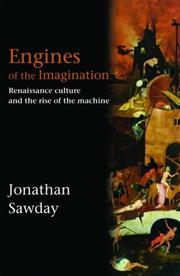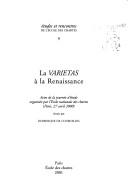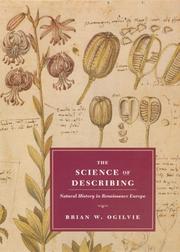| Listing 1 - 10 of 10 |
Sort by
|
Book
Abstract | Keywords | Export | Availability | Bookmark
 Loading...
Loading...Choose an application
- Reference Manager
- EndNote
- RefWorks (Direct export to RefWorks)
Architecture --- Architecture, Renaissance --- Architektur. --- Renaissance. --- History. --- Geschichte 1400-1600. --- Geschichte 1420-1600. --- Italien.
Periodical
ISSN: 14233983 Year: 2016 Publisher: Genève Barbier-Mueller
Abstract | Keywords | Export | Availability | Bookmark
 Loading...
Loading...Choose an application
- Reference Manager
- EndNote
- RefWorks (Direct export to RefWorks)
Italian poetry --- Poésie italienne --- History and criticism --- Periodicals --- Histoire et critique --- Périodiques --- Renaissance. --- Lyrik. --- Zeitschrift. --- Geschichte 1420-1600 --- Italienisch. --- Geschichte --- 1420-1600 --- Arts and Humanities --- Literature
Book
ISBN: 9783499554469 Year: 1988 Publisher: Reinbek bei Hamburg : Rowohlt Taschenbuch Verlag,
Abstract | Keywords | Export | Availability | Bookmark
 Loading...
Loading...Choose an application
- Reference Manager
- EndNote
- RefWorks (Direct export to RefWorks)
Bewegungskultur. --- Cultuur. --- Human body --- Körper. --- Leib. --- Mensch. --- Menselijk lichaam. --- Naturbeherrschung. --- Natuur. --- Physical education and training --- Physical education and training. --- Renaissance. --- Sozialgeschichte. --- Tanz. --- Social aspects --- History --- Social aspects. --- Geistesgeschichte 1400-1600. --- Geschichte 1420-1600. --- Sozialgeschichte 1400-1600. --- Europe.

ISBN: 9780415350624 041535062X 0415350611 0203696158 9780415350617 9780203696156 9781134267880 9781134267927 9781134267934 Year: 2007 Publisher: London: Routledge,
Abstract | Keywords | Export | Availability | Bookmark
 Loading...
Loading...Choose an application
- Reference Manager
- EndNote
- RefWorks (Direct export to RefWorks)
Engineering sciences. Technology
---
History of civilization
---
anno 1600-1699
---
anno 1400-1499
---
anno 1500-1599
---
Machinery
---
History
---
930.85.44
---
Cultuurgeschiedenis: Renaissance
---
Maschine
---
Maschine.
---
Motiv (Literatur)
---
Technik
Periodical
ISSN: 16634438 14233983 Year: 1998 Publisher: Genève : Fondation Barbier-Mueller : Librairie Droz,
Abstract | Keywords | Export | Availability | Bookmark
 Loading...
Loading...Choose an application
- Reference Manager
- EndNote
- RefWorks (Direct export to RefWorks)
La revue Italique est consacrée à l’étude de la poésie italienne de la Renaissance dans la période qui va de Pétrarque à l’âge baroque. Un véritable âge d’or, si l’on songe à l’archétype des Rerum vulgarium Fragmenta et aux canzonieri du XVIe siècle, mais aussi une époque pleine de contradictions, quand on pense au conflit du vulgaire avec l’humanisme latin au cours du « siècle sans poésie », de la mort de Pétrarque à Laurent le Magnifique. Le Tasse, Chiabrera et le Cavalier Marin, à la fin du XVIe siècle, ébranlent la toute-puissance des modèles classiques en procédant à la liquidation de l’idéal pétrarquiste. Cette poésie italienne, en latin et en langue vulgaire, a représenté des siècles durant la poésie par excellence et a constitué pour tous un modèle. Son intense maniérisme, la cadence harmonieuse de son style, qui faisaient autrefois son prix, la tiennent à l’écart du goût contemporain, si friand d’originalité.
Italian poetry
---
Poésie italienne
---
Renaissance.
---
Lyrik.
---
Zeitschrift.
---
History and criticism
---
Histoire et critique
---
Geschichte 1420-1600
---
Italienisch.
---
Geschichte
---
1420-1600
---
Poésie italienne
---
Italian literature
---
Italian poetry.
---
To 1599
---
Geschichte 1400-1600.
---
Geschichte 1420-1600.
---
Periodikum
---
Zeitschriften
---
Presse
---
Fortlaufendes Sammelwerk
---
Humanismus
---
Gedicht
---
Poem
---
Dichtung
---
Poesie
---
Lyrisches Werk
---
Lyrikwerk
---
Gedichtwerk
---
Literatur
---
<
Book
ISBN: 0719029252 9780719029257 0719043220 9780719043222 Year: 1991 Publisher: Manchester Manchester University Press
Abstract | Keywords | Export | Availability | Bookmark
 Loading...
Loading...Choose an application
- Reference Manager
- EndNote
- RefWorks (Direct export to RefWorks)
History of civilization --- Religious studies --- anno 1500-1599 --- Europe --- Science [Renaissance ] --- Science de la Renaissance --- Wetenschap [Renaissance-] --- Intellectual life --- 17th century --- Science, Renaissance. --- Europe - Intellectual life - 17th century. --- Aufsatzsammlung. --- Culture. --- Cultuur. --- Geschichte (1420-1600). --- Geschichte 1500-1600. --- Intellectual life. --- Renaissance. --- Science --- Sciences de la Renaissance. --- Volksgeloof. --- Volksglaube. --- Wetenschap. --- Wissenschaft. --- culture (concept). --- culture note. --- History. --- Europa. --- 1600-1699. --- Europe. --- Social life and customs --- Vie intellectuelle
Book
ISBN: 9781409400240 9781409423997 1409400247 1409423999 1317066391 9786612892752 1315605317 1282892754 9781315605319 9781317066385 9781317066392 9781138245488 Year: 2010 Volume: *22 Publisher: Aldershot: Ashgate,
Abstract | Keywords | Export | Availability | Bookmark
 Loading...
Loading...Choose an application
- Reference Manager
- EndNote
- RefWorks (Direct export to RefWorks)
How are processes of vision, perception, and sensation conceived in the Renaissance? How are those conceptions made manifest in the arts? The essays in this volume address these and similar questions to establish important theoretical and philosophical bases for artistic production in the Renaissance and beyond. The essays also attend to the views of historically significant writers from the ancient classical period to the eighteenth century, including Plato, Aristotle, Plotinus, St Augustine, Ibn Sina (Avicenna), Ibn al-Haytham (Alhazen), Ibn Sahl, Marsilio Ficino, Nicholas of Cusa, Leon Battista Alberti, Gian Paolo Lomazzo, Gregorio Comanini, John Davies, Rene Descartes, Samuel van Hoogstraten, and George Berkeley.
History --- Renaissance --- Aesthetics --- Christian special devotions --- art theory --- Affective and dynamic functions --- Art --- Descartes, René --- anno 1400-1499 --- anno 1500-1599 --- Visual perception --- Vision --- Perspective --- Art, Renaissance. --- Perception visuelle --- Art de la Renaissance --- History. --- Philosophy. --- Histoire --- Philosophie --- Art, Renaissance --- Philosophy --- Geschichte 1420-1600. --- Art -- Philosophy. --- Perspective -- History. --- Visual perception -- History. --- Visual Arts --- Art, Architecture & Applied Arts --- Visual Arts - General --- Visual perception - History --- Vision - History --- Perspective - History --- Art - Philosophy
Book
ISBN: 9781935408024 9781942130345 1942130341 193540802X Year: 2012 Publisher: New York: Zone books,
Abstract | Keywords | Export | Availability | Bookmark
 Loading...
Loading...Choose an application
- Reference Manager
- EndNote
- RefWorks (Direct export to RefWorks)
A reconsideration of the problem of time in the Renaissance, examining the complex and layered temporalities of Renaissance images and artifacts. In this widely anticipated book, two leading contemporary art historians offer a subtle and profound reconsideration of the problem of time in the Renaissance. Alexander Nagel and Christopher Wood examine the meanings, uses, and effects of chronologies, models of temporality, and notions of originality and repetition in Renaissance images and artifacts. Anachronic Renaissance reveals a web of paths traveled by works and artists―a landscape obscured by art history's disciplinary compulsion to anchor its data securely in time. The buildings, paintings, drawings, prints, sculptures, and medals discussed were shaped by concerns about authenticity, about reference to prestigious origins and precedents, and about the implications of transposition from one medium to another. Byzantine icons taken to be Early Christian antiquities, the acheiropoieton (or “image made without hands”), the activities of spoliation and citation, differing approaches to art restoration, legends about movable buildings, and forgeries and pastiches: all of these emerge as basic conceptual structures of Renaissance art. Although a work of art does bear witness to the moment of its fabrication, Nagel and Wood argue that it is equally important to understand its temporal instability: how it points away from that moment, backward to a remote ancestral origin, to a prior artifact or image, even to an origin outside of time, in divinity. This book is not the story about the Renaissance, nor is it just a story. It imagines the infrastructure of many possible stories
Art --- anno 500-1499 --- anno 1500-1599 --- Art, Renaissance. --- Architecture, Renaissance. --- Building materials --- Time and art. --- Recycling. --- Architecture, Renaissance --- Art, Renaissance --- Time and art --- Art and time --- Architectural materials --- Architecture --- Building --- Building supplies --- Buildings --- Construction materials --- Structural materials --- Materials --- Renaissance art --- Renaissance architecture --- Renaissance revival (Architecture) --- Recycling --- Renaissance --- Analyse de l'art --- kunst --- kunsttheorie --- 7.01 --- 7.034 --- renaissance --- tijdelijkheid --- tijd --- Geschichte 1420-1550. --- Geschichte 1420-1600. --- 1400-1500. --- 1500-1600. --- Art de la Renaissance --- Architecture de la Renaissance --- Construction --- Temps et art --- Matériaux --- Recyclage

ISBN: 290079143X 9782900791431 2357231386 Year: 2001 Volume: 9
Abstract | Keywords | Export | Availability | Bookmark
 Loading...
Loading...Choose an application
- Reference Manager
- EndNote
- RefWorks (Direct export to RefWorks)
À la Renaissance le développement de la philologie instaure la rénovation des savoirs philosophiques et théologiques, les grandes découvertes impliquent de nouvelles représentations du monde et de l’homme, les luttes religieuses déchirent l’Occident, cependant que s’affirment les identités nationales amorçant ainsi la reconfiguration de l’Europe. La notion de varietas apparaît comme un principe majeur des formes nouvelles de pensée, d’écriture et de vie, comme un principe ordonnateur de toute la culture humaniste. Les analyses présentées ressortissent aux différentes problématiques de l’histoire de la philologie, de la littérature, de la philosophie, de l’histoire de l’art, de la musicologie. Elles mettent en œuvre des méthodes diverses.
Art, Renaissance --- Rhetoric --- Style, Literary --- Art de la Renaissance --- Rhétorique --- Style littéraire --- Congresses --- Congrès --- 09 <063> --- 87.085 --- 091.14 --- 113/119 --- Handschriften. Oude en merkwaardige drukken. Curiosa--Congressen --- Klassieke literatuur: retorica --- Codicologie. Codices. Scriptoria --- Kosmologie. Natuurfilosofie. Filosofie van de natuur --- 113/119 Kosmologie. Natuurfilosofie. Filosofie van de natuur --- 091.14 Codicologie. Codices. Scriptoria --- 87.085 Klassieke literatuur: retorica --- 09 <063> Handschriften. Oude en merkwaardige drukken. Curiosa--Congressen --- Literary style --- Rhétorique --- Style littéraire --- Congresses. --- Congrès --- Architecture --- Periodicals --- History --- Bibliography --- 20.70 European art. --- Architecture de la Renaissance --- Architecture, Renaissance --- Architecture, Renaissance. --- Art, Renaissance. --- Arts de la Renaissance --- Arts, Renaissance --- Arts, Renaissance. --- Kongress. --- Renaissance. --- Stilistik. --- Variation. --- Varietas. --- Congrès. --- Geschichte 1420-1600. --- Humanities, Multidisciplinary --- Renaissance --- musique --- philologie --- philosophie --- littérature --- théologie --- critique littéraire --- architecture --- varietas --- Varietas (le mot latin) --- Rhétorique de la Renaissance --- Philologie

ISBN: 128196610X 9786611966102 0226620867 9780226620862 9780226620879 0226620875 9781281966100 0226620875 6611966102 0226620883 9780226620886 Year: 2006 Publisher: Chicago : University of Chicago Press,
Abstract | Keywords | Export | Availability | Bookmark
 Loading...
Loading...Choose an application
- Reference Manager
- EndNote
- RefWorks (Direct export to RefWorks)
Out of the diverse traditions of medical humanism, classical philology, and natural philosophy, Renaissance naturalists created a new science devoted to discovering and describing plants and animals. Drawing on published natural histories, manuscript correspondence, garden plans, travelogues, watercolors, and drawings, The Science of Describing reconstructs the evolution of this discipline of description through four generations of naturalists. In the late fifteenth and early sixteenth centuries, naturalists focused on understanding ancient and medieval descriptions of the natural world, but by the mid-sixteenth century naturalists turned toward distinguishing and cataloguing new plant and animal species. To do so, they developed new techniques of observing and recording, created botanical gardens and herbaria, and exchanged correspondence and specimens within an international community. By the early seventeenth century, naturalists began the daunting task of sorting through the wealth of information they had accumulated, putting a new emphasis on taxonomy and classification. Illustrated with woodcuts, engravings, and photographs, The Science of Describing is the first broad interpretation of Renaissance natural history in more than a generation and will appeal widely to an interdisciplinary audience.
Science --- Natural history --- Science, Renaissance. --- Renaissance science --- History, Natural --- Natural science --- Physiophilosophy --- Biology --- Natural sciences --- Science of science --- Sciences --- History --- Science, Renaissance --- 094:58 --- 094:59 --- 094:59 Oude en merkwaardige drukken. Kostbare en zeldzame boeken. Preciosa en rariora-:-Zoologie. Dierkunde --- Oude en merkwaardige drukken. Kostbare en zeldzame boeken. Preciosa en rariora-:-Zoologie. Dierkunde --- 094:58 Oude en merkwaardige drukken. Kostbare en zeldzame boeken. Preciosa en rariora-:-Botany --- Oude en merkwaardige drukken. Kostbare en zeldzame boeken. Preciosa en rariora-:-Botany --- Pure sciences. Natural sciences (general) --- science [modern discipline] --- description [activity] --- 42.05 natural history. --- Beschreibung. --- Illustration. --- Kunst. --- Natur. --- Natural history. --- Naturbeobachtung. --- Naturgeschichte --- Natuurlijke historie. --- Renaissance. --- Science. --- Sciences de la Renaissance. --- Sciences naturelles --- Wissenschaft. --- Histoire --- 1500-1599. --- Geschichte 1420-1600. --- Geschichte 1500-1650. --- Europa --- Europa. --- Europe. --- Illustration --- Kunst --- Wissenschaft --- Science - Europe - History - 16th century. --- Natural history - Europe - History - 16th century. --- science, scientific, natural history, historical context, renaissance, europe, european, description, traditions, medical humanism, classical philosophy, philosophical, naturalists, naturalism, discovery, discovering, plants, animals, correspondence, garden plans, travelogues, watercolors, art, artwork, drawings, development, distinguishing, cataloging, characteristics, species, nature, taxonomy, classification, 16th century, interdisciplinary studies, common sense.
| Listing 1 - 10 of 10 |
Sort by
|

 Search
Search Feedback
Feedback About UniCat
About UniCat  Help
Help News
News